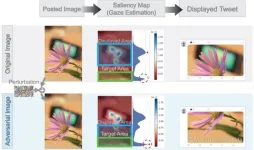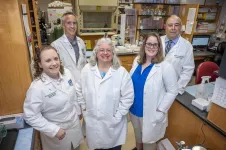(Press-News.org) Much of the water in the West is transported across vast geographical areas by large infrastructure projects known as interbasin water transfers. Two of these projects in particular make up 85% of all energy-related greenhouse gas emissions associated with U.S. interbasin transfers — one in Arizona and the other in California — according to the new research published this week in the journal Nature Water.
The project in Arizona is known as the Central Arizona Project and in California it’s the State Water Project.
“You hear a lot about these big projects and how much energy they use,” said Avery Driscoll, a doctoral student in CSU’s Department of Soil and Crop Sciences and the paper’s lead author. “We were curious how much of that was actually attributable to agriculture and what the emissions impact was.”
In gathering and analyzing data from 2018 to 2022, Driscoll excluded the portions of interbasin transfers that are used for non-irrigation sources such as municipal water supplies. During the five years of data Driscoll reviewed, approximately 41% of the Central Arizona Project and about 34% of California’s State Water Project went to ag.
Colorado’s largest interbasin water transfer project, the Colorado-Big Thompson project, or CBT, was third on the list. However, it accounted for a much smaller portion of the energy-related greenhouse gas emissions comparatively, roughly 6%. From 2018 to 2022, about 45% of the CBT project, which is operated by Northern Water, was used for agriculture.
Driscoll reviewed data for 106 projects, with the Arizona, California and Colorado projects accounting for 91% of the energy use tied to irrigation from interbasin transfers. “Although energy use for interbasin transfers is the dominant emissions source in only 15 counties,” the study’s authors wrote, “the emissions impact is substantial in those locations.”
“I was surprised it was so consolidated,” Driscoll said. “I think it’s also a testament to the fact that a lot of these transfers aren’t being used for irrigation because it’s expensive.” She added, “Farmers are not going to pay as much as municipalities for the water, so it’s just less feasible to be using trans-basin water for irrigation.”
A full irrigation emissions picture
The new paper in Nature Water builds on earlier work by Driscoll and her co-authors published in Nature Communications. That paper cataloged energy use tied specifically to on-farm groundwater pumping in the U.S., which is nearly four times more emissions-intensive than surface water irrigation. Groundwater use accounts for 79% of irrigation-related emissions despite providing only 49% of U.S. irrigation water.
These two papers combined represent the “most comprehensive national-scale analysis of irrigation related emissions” available, according to the study’s authors.
“Irrigation is an essential climate change adaptation strategy, but we’re showing here that irrigation presents some important tradeoffs with our greenhouse gas mitigation goals,” said CSU Associate Professor Nathan Mueller, a co-author on the study. “On the other hand, irrigation allows for incredible boosts in crop productivity, so we need to recognize the considerable benefits of irrigation while attempting to minimize the greenhouse gas costs.”
In addition to water transfer projects, the Nature Water paper also catalogs irrigation-related greenhouse gas emissions associated with groundwater degassing and nitrification. For these two categories, the impact tended to vary greatly based on location.
Groundwater degassing refers to the natural process by which dissolved gases release into the atmosphere after groundwater is applied to a field. The study’s authors found that groundwater degassing was “the dominant emissions source in 55 counties (10% of irrigated land), including much of the Lower Mississippi River Valley region.”
Irrigating farmland can also cause increased amounts of nitrous oxide, a potent greenhouse gas, to be released into the atmosphere through a natural biological process called denitrification. The study found that nitrous oxide emissions were the dominant source of irrigation-related emissions in only 7% of U.S. counties.
Driscoll and Mueller view this accounting as being applicable in many contexts, including to help inform national emissions and reduction efforts as well as current greenhouse gas accounting frameworks.
“Greenhouse gas emissions from agriculture are complicated because they involve so many different mechanisms, and we found that irrigation-related emissions are no exception,” Mueller said. “The good news is that we can address most of these emissions through relatively straightforward changes to our energy and agricultural systems — electrifying and decarbonizing pumping systems along with the grid.”
END
Research catalogs greenhouse gas emissions tied to energy use for interbasin water transfers
2024-08-01
ELSE PRESS RELEASES FROM THIS DATE:
Largest study to date finds multiple urinary metals play key role in cardiovascular disease and mortality
2024-08-01
Higher levels of urinary metals such as cadmium, tungsten, uranium, cobalt, copper and zinc are linked to increased cardiovascular disease and mortality in a racially and ethnically diverse U.S. population, according to a new study at Columbia University Mailman School of Public Health. While it is well documented that exposure to certain metals has been associated with cardiovascular disease (CVD) and mortality, until now the evidence was limited beyond arsenic, cadmium, and lead and for a racially diverse population. The findings are published in the journal Circulation.
When analyzed together, ...
Tipping risks from overshooting 1.5 °C can be minimised if warming is swiftly reversed
2024-08-01
Human-made climate change can lead to a destabilisation of large-scale components of the Earth system such as ice sheets or ocean circulation patterns, the so-called tipping elements. While these components will not tip over night, fundamental processes are put into motion unfolding over tens, hundreds or thousands of years. These changes are of such a serious nature that they should be avoided at all costs, the researchers argue. In their new study, they assessed the risks of destabilisation of at least one ...
Which strains of tuberculosis are the most infectious?
2024-08-01
For some forms of tuberculosis, the chances that an exposed person will get infected depend on whether the individual and the bacteria share a hometown, according to a new study comparing how different strains move through mixed populations in cosmopolitan cities.
Results of the research, led by Harvard Medical School scientists and published Aug. 1 in Nature Microbiology, provide the first hard evidence of long-standing observations that have led scientists to suspect that pathogen, place, and human host ...
New AI tool simplifies heart monitoring: Fewer leads, same accuracy
2024-08-01
LA JOLLA, CA—To diagnose heart conditions including heart attacks and heart rhythm disturbances, clinicians typically rely on 12-lead electrocardiograms (ECGs)—complex arrangements of electrodes and wires placed around the chest and limbs to detect the heart’s electrical activity. But these ECGs require specialized equipment and expertise, and not all clinics have the capability to perform them.
Now, a team of scientists and clinicians from Scripps Research has shown that heart conditions can be diagnosed roughly as accurately using just three electrodes and an artificial intelligence (AI) tool. In a ...
Tipping risks from overshooting 1.5°C can be minimized if warming is swiftly reversed
2024-08-01
Current climate policies imply a high risk for tipping of critical Earth system elements, even if temperatures return to below 1.5°C of global warming after a period of overshoot. A new study indicates that these risks can be minimized if warming is swiftly reversed.
Human-made climate change can lead to a destabilization of large-scale components of the Earth system such as ice sheets, ocean circulation patterns, or global biosphere components, the so-called tipping elements. In their new study published in Nature Communications, researchers from IIASA and the Potsdam Institute for Climate Impact Research (PIK) analyzed the risks for four interconnected core climate tipping elements ...
Comprehensive meta-analysis pinpoints what vaccination strategies different countries should adopt
2024-08-01
Vaccines are safe and effective, and help reduce death and illness. But global vaccination rates are suboptimal and have trended downward, leaving humanity more vulnerable to vaccine-preventable diseases such as COVID-19, influenza, measles, polio, and HPV.
Identifying interventions that could increase vaccine coverage could help save lives. A new paper from a team led by researchers at the University of Pennsylvania offers the first comprehensive meta-analysis examining what types of vaccine intervention strategies have the ...
Predicting the future: Easy tool helps estimate fall risks
2024-08-01
Osaka, Japan — An aging society has posed a new global problem, the risk of falling. It is estimated that 1 in 3 adults over the age of 65 falls each year and the resulting injuries are becoming more prevalent.
To tackle this growing issue, Associate Professor Hiromitsu Toyoda and Specially Appointed Professor Tadashi Okano from Osaka Metropolitan University’s Graduate School of Medicine, together with Professor Chisato Hayashi from the University of Hyogo, have developed a formula and assessment tool for estimating fall risks that is simple for older adults to use. The tool was developed using data collected from older adults over a ten-year period from April 2010 to December ...
Eccentric-only resistance training can lower passive muscle stiffness
2024-08-01
Resistance, or weight training, is widely recommended in sports and rehabilitation as an effective exercise to increase muscular strength and size. This form of exercise involves applying resistance to muscle contraction to build strength. However, some practitioners believe resistance training can increase passive muscle stiffness over time. Passive muscle stiffness is a key indicator of how muscles behave mechanically when they are stretched without active contraction. Specifically, it refers to the amount of force required to change the muscle length by a given amount during passive stretching. Studies ...
Enhancing automatic image cropping models with advanced adversarial techniques
2024-08-01
Image cropping is an essential task in many contexts, right from social media and e-commerce to advanced computer vision applications. Cropping helps maintain image quality by avoiding unnecessary resizing, which can degrade the image and consume computational resources. It is also useful when an image needs to conform to a predetermined aspect ratio, such as in thumbnails. Over the past decade, engineers around the world have developed various machine learning (ML) models to automatically crop images. These models aim to crop an input image in a way that preserves its most relevant parts.
However, ...
$2.4 million grant helping MCG scientists better understand what happens to our skeleton as we age
2024-08-01
AUGUSTA, Ga. (Aug. 1, 2024) – Figuring out how the tissues in our bones, adrenal glands, muscle and fat “talk” to each other could help scientists better understand what happens to our skeletons with age, when our bones tend to lose mass and become weaker, leaving us at risk for falls and fractures.
“Tissues don’t function in isolation – everything in the body “talks” to everything else to keep people healthy across the lifespan,” explains Meghan McGee-Lawrence, PhD, bone biologist at the Medical College of Georgia at ...




